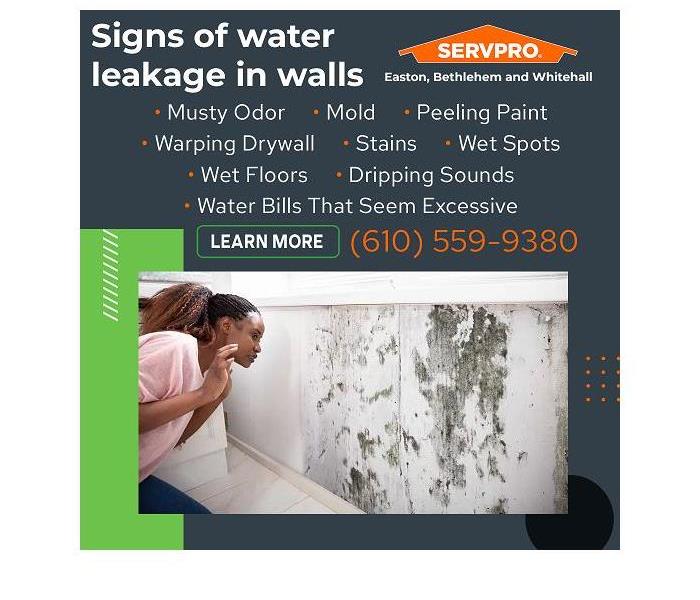How To Find A Water Leak Inside A Wall
4/26/2022 (Permalink)
Blog Summary: This article by SERVPRO of Easton, Bethlehem, and Whitehall outlines how a water leak inside a wall can be identified.
Keeping homes clean and beautiful is a priority for most homeowners. Regular maintenance work helps keep homes clean and safe. Property damage can be caused by negligence, or due to sudden accidental causes. Water damage also can be due to sudden and catastrophic reasons, or a cause that remains hidden and causes slow changes.
Water leakage inside walls may not be noticed, as the initial signs can be very subtle. Water damage is one of the most common types of property damage in the US. Water damage can have serious consequences and water damage restoration is done by professionals to limit the complications. SERVPRO of Easton, Bethlehem, and Whitehall provides cleanup and restoration services after a fire, smoke, or water damage to different locations, including Schnecksville, PA. This locally owned company with national resources is the best choice for water damage repair services. In this article SERVPRO of Easton, Bethlehem, and Whitehall shares some information on identifying water leaks inside walls.
Signs of water leakage in walls
Sometimes leakage within walls can be slow and may not be evident. Identifying water leakage early enough can help minimize the extent of water damage. The signs of leaking in walls are:
Musty Odor
Water might leak slowly, but it can cause dampness inside walls, flooring, or drywall. This can lead to a musty smell that persists.
Mold
Mold growing in areas that are usually dry, and where there is usually no chance of moisture accumulating.
Peeling Paint
Paint or wallpaper that bubbles or peels can be an indication of leaking within the wall.
Warped Drywall
When drywall absorbs moisture from slow leakage the wall can get bent or curved. This warping is a sign of a slow water leak.
Stains
Mold growing around a leaking pipe can spread to the inside surface of the wall. This can show on the outside of the wall as staining or discoloration.
Wet Spots
Wet patches on the wall are definite signs of water leakage. However, the spots may not be at the location of the leak. Water can move down from the leaking pipe and cause wetness on the wall below the actual source of the leak.
Wet Floors
Wet areas on the floor or damp carpeting near walls can indicate leaking within the walls.
Dripping Sounds
There can be sounds of water dripping when it runs down inside walls. These sounds are usually heard after turning off the faucet in a sink or tub, or after flushing a toilet.
Water Bills That Seem Excessive
Most families in the US use around 300 gallons of water a day according to the EPA. An undetected leak can cause water bills to rise in a way that is unexplainable by what the household is using.
Detecting Water Leaks in Walls
Water Meter Check
Checking the water meter is an easy way to detect water leakage. First, the water meter reading must be checked and noted, this would be the measure of water used. All faucets, showers, toilets, and any appliances that use water must be turned off. Water must not be used for at least 3 hours. During this time faucets, toilets, etc must be checked for any leaks. After this time, the water meter reading can be checked. Any increase in the reading means there is water leakage somewhere in the house.
Moisture Meter
Moisture meters are used to measure the moisture content in materials. They are available in home improvement stores. A pin-type moisture meter helps to check moisture levels for small, precise spots. The pinless ones are used to scan larger areas. Using moisture meters requires time and effort. Professionals use both types of water meters to locate large areas of moisture and to find the exact depth at which leaks originate.
Infrared Camera
An optical system in infrared cameras measures infrared energy and surface temperature. At wet spots, the cooler temperature displays blue or purple colors. This is a quick and non-invasive way of detecting leakages within the walls.
Cutting Into Drywall
Drywall can be cut to see exactly what the condition behind a wall is. This is invasive and is usually a last resort. A stain or discoloration on the wall may be at a different place from the actual leak. So drywall should be cut after trying to locate the source of water leakage.
Handling A Water Leak In Walls
Preventing water leaks by regular checks and maintenance is the best way to prevent or limit water damage. Once there has been a water leak in the walls, the source of the leak must be identified, and repair work done to stop the leak. Water removal must be done and the area dried as soon as possible. The area must be cleaned. Water damage repair is best handled by experts, especially when damage is more than minimal. Mold growth is a risk, and clean-up after such water damage must focus on this too.
Homeowners must try to prevent leakage in walls. However, when this does occur, they can always get professional help for water damage restoration. SERVPRO of Easton, Bethlehem, and Whitehall are experienced, skilled, and trained professionals who handle water damage repair efficiently. They use advanced inspection and extraction equipment to find water, remove it, and dry the area. For any water damage repair caused by flooding or leaks in Schnecksville, PA SERVPRO can be contacted at (610) 559-9380. Any size of water emergency in Schnecksville can be handled by the water damage specialists at SERVPRO of Easton, Bethlehem, and Whitehall.





 24/7 Emergency Service
24/7 Emergency Service
